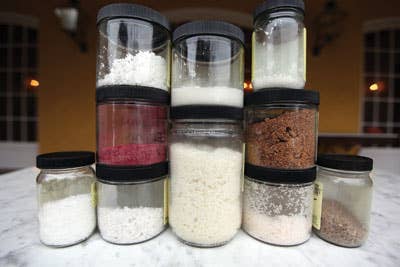
I grew up in Hawaii, on the south shore of Oahu. The waves come in clean and rough there; seawater collects amid lava rocks and heats in the sun. Walking among the pools as a kid, I could see the salt forming. I'd scoop it up and take it home. It had an umami flavor from the red ogo seaweed in the tide.
A few years back, I started harvesting sea salt to use in the kitchen at Jordan Vineyard & Winery in California's Sonoma County, where I'm the chef. The first time I tried it was in Naxos, Greece, during the summer: It was so hot, I just left the seawater outside to dehydrate. Four days later, I had big dusky flakes. The salt had a smokiness that was great on lamb.
For me, harvesting sea salt is a way of extending the concept of terroir; the salt takes on the character of the waters it comes from, and it pairs beautifully with local foods. Off Kauai, Hawaii, the sea is iron-rich; the salt adds meaty notes to pork dishes. In Baja, Mexico, I collected crystal-clear seawater while fishing; the resulting salt was pure and briny—perfect to cure and grill the mackerel I caught there.
Making salt is easy enough, and if done properly, it's safe. I stay away from storm runoff and collect in areas where the sea is pristine. First, I boil the water for a minimum of six minutes to kill bacteria. Then I set it in a nonreactive shallow pan in the sun to slowly dehydrate. That way, I get large, natural crystals, which add beautiful texture to dishes. If I'm in a rush, I boil out the water on the stove; the crystals end up smaller, but the flavor is the same. I love it because it's a living souvenir of my travels; every one of my salts has a story. I've even taken to mixing the salts with other ingredients, like dried tomatoes or juniper.
Keep Reading
Continue to Next Story










